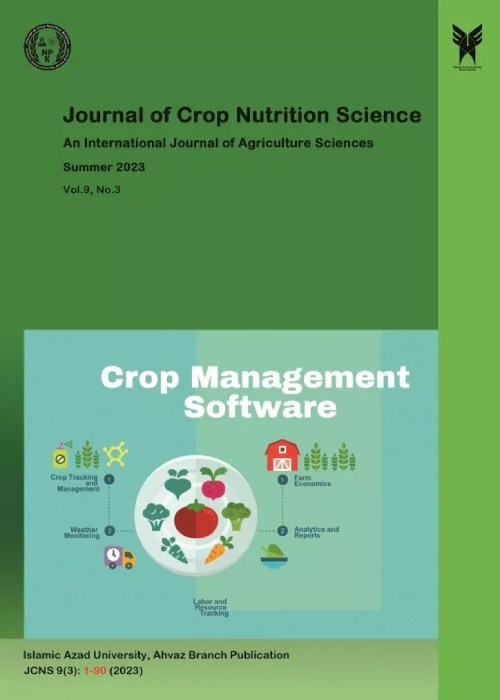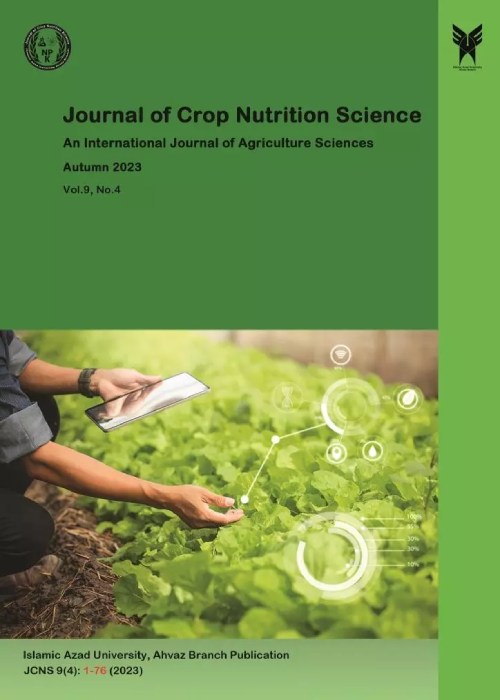فهرست مطالب

Journal of Crop Nutrition Science
Volume:9 Issue: 3, Summer 2023
- تاریخ انتشار: 1402/06/10
- تعداد عناوین: 6
-
Pages 1-10BACKGROUNDThe utilization of substances like salicylic acid and glycine betaine has proven to be beneficial in enhancing plant tolerance to environmental stresses, particularly drought. These compounds act as antioxidants, playing a vital role in diminishing the generation of reactive oxygen species (ROS), enhancing the efficiency of chloroplasts and promoting the synthesis of protective compounds such as proline.OBJECTIVESInvestigate the use of salicylic acid and glycine betaine on qualitative properties of alfalfa under water stress conditions.METHODSThis research was conducted as split plot experiment based on randomized complete blocks design (RCBD) with three replications during 2018-2019 cropping season at Karaj Botanical Research Institute. The main plots consisted of three levels of irrigation (including full irrigation, cut-off irrigation from the beginning of flowering until the end of the growing season, cut-off irrigation from 50% of flowering until the end of the growing season). The sub-plots included foliar application of stress reducing agents with 5 levels (including control (without foliar spraying), 0.5 mM salicylic acid, 1 mM salicylic acid, 10 mM glycine, and 50 mM glycine).RESULTThe results indicated that water deficit had a significant effect on all the studied traits and the application of stress-reducing agents effectively mitigated the adverse effects of water stress. Among the qualitative properties, the combined treatment of full irrigation and foliar application of glycine betaine yielded the most favorable results. The use of 10 mM glycine betaine is recommended for enhancing alfalfa's response to water stress. In both stress treatments (i.e., cessation of irrigation from the beginning of flowering and cessation of irrigation from 50% of flowering), the use of stress-reducing treatments resulted in a significant reduction in the negative impact of stress on most traits. So, the difference in means between the treatments with and without stress-reducing agents was significant.CONCLUSIONCurrent research suggests application of stress-reducing agents, such as glycine betaine and salicylic acid, can be beneficial in improving alfalfa's performance under water stress conditions, so contributing to better crop yield and quality. Further research and implementation of these stress-alleviating strategies can offer promising prospects for sustainable alfalfa cultivation in challenging environments.Keywords: digestible dry matter, Fiber, Forage crop, Protein, Soluble sugars
-
Pages 11-32BACKGROUNDThe application of paclobutrazol as a growth stimulant not only increases the cold tolerance of sugarcane but also enhances its yield.OBJECTIVESTo investigate the effect of different concentrations of paclobutrazol in enhancing winter tolerance of sugarcane variety CP48-103 this study was carried out.METHODSCurrent research was done during the 2013 cropping season according randomized complete block design (RCBD) with three replications. The studied treatments were as control group (untreated(, burning of cold-damaged shoots, harvesting cold-damaged shoots without hormone consumption, harvesting cold-damaged shoots and spraying with a solution of 100 mg.lit-1 paclobutrazol, harvesting cold-damaged shoots and spraying with a solution of 150 mg.lit-1 paclobutrazol, spraying solution on cold-damaged shoots with a concentration of 100 mg.lit-1 paclobutrazol, spraying solution on cold-damaged shoots with a concentration of 150 mg.lit-1 paclobutrazol.RESULTThe highest chlorophyll content, measured at 40 (Spad), was observed in harvesting cold-damaged shoots and spraying with a solution of 150 mg.lit-1 paclobutrazol. Among the treatments, the highest amount of syrup (with an average of 31%) was observed in the treatment of burning of cold-damaged shoots, while the lowest amount (with an average of 28%) was found in the treatment of harvesting cold-damaged shoots without hormone consumption. The sucrose percentage displayed a significant increase from October 15 to October 30 in different treatments. This indicates that the sucrose content in the sugarcane increased during this period across all treatments. The burning treatment resulted in the lowest percentage of sucrose, with an average of 11%. The percentage of extractable sugar reached its peak on December 6 and across different treatments, the highest amount of extractable sugar (with an average of 8.5%) was obtained from treatment involving the harvesting cold-damaged shoots and spraying with a solution of 150 mg.lit-1 paclobutrazol. In terms of stem yield, the highest and lowest values (with an average of 59800 and 51280 kg.ha-1, respectively) were recorded in treatment of harvesting cold-damaged shoots and spraying with a solution of 150 mg.lit-1 paclobutrazol and control treatment, respectively.CONCLUSIONThe treatment involving the application of paclobutrazol significantly increased the stem yield of sugarcane compared to the control treatment.Keywords: Brix, Chlorophyll, phosphorus, Sucrose, Sugar yield, Syrup purity
-
Pages 33-48BACKGROUNDThe response of different canola varieties to irrigation cut-off and changes in planting dates depends on various factors such as climatic conditions, soil type, and specific characteristics of the varieties and growth stages of the plants. Each canola variety may react differently to variations in water and shifts in planting dates.OBJECTIVESTo investigate the effects of irrigation cut-off and planting date on the seed yield and its components of rapeseed cultivars current research was done.METHODSThis study was conducted as factorial split plot experiment based on randomized complete block design (RCBD) with three replications. The main plots were assigned to irrigation treatments [including regular irrigation (where irrigation was applied after 80 mm of evaporation from Class A pan) and irrigation cut-off from silique formation stage onwards]. The sub-plots were assigned to different planting dates, including September 27 and October 27 and four winter rapeseed cultivars (Tassilo, Elvise, Neptune and Okapi) were evaluated in a factorial arrangement in sub-plots.RESULTBoth irrigation cut-off and delayed planting date had a significant impact on various growth and yield-related traits in rapeseed cultivars. Reduced plant height, fewer sub-branches per plant, fewer siliques per plant, fewer seeds per pod and lower 1000-seed weight. Also, different rapeseed cultivars that were studied exhibited significant variations in all evaluated traits. Among the cultivars, Elvise and Neptune stood out as they achieved the highest seed yields. Under normal irrigation conditions, Elvise yielded 3346 kg.ha-1, while Neptune produced 3220 kg.ha-1. Even under irrigation cut-off conditions, these cultivars still demonstrated promising performance, with Elvise yielding an average of 3211 kg.ha-1 and Neptune yielding 3081 kg.ha-1.CONCLUSIONThis advantage in seed yield was primarily attributed to an increase in the sink capacity of the yield components. As a result, Elvise and Neptune cultivars can be recommended as suitable choices for rapeseed production, as they have shown not only high seed yields under normal irrigation conditions but also stable production capabilities even under water stress conditions after pod formation.Keywords: Drought stress, Genotypes, Rapeseed, Seed yield, Sowing date
-
Pages 49-64BACKGROUNDChoosing the right planting date, managing plant food sources and identifying traits that increase yield are the most important factors of success in increasing agricultural production.OBJECTIVESTo investigate the regression and correlation relationships among the factors affecting the yield of black cumin under the influence of planting date and different sources of nitrogen supply, a study was done.METHODSThis research was conducted according factorial split plots experiment based on randomized complete block design (RCBD) with three replications. Seven levels of nitrogen sources (including urea, manure fertilizer, Azotobacter, urea + manure fertilizer, urea + Azotobacter, Azotobacter + manure fertilizer, and urea + Azotobacter + manure fertilizer) as the first factor in the main plots. Additionally, two planting dates (November 22 and February 14) and two black cumin cultivars (Arak and Semirom) were considered as the secondary factors and were factorially assigned to the sub-plots.RESULTThe number of seeds per plant showed the highest explanatory coefficient with a justification of 93.16% of the changes in seed yield, indicating its significant influence on seed production. Moreover, the correlation coefficients between seed yield and the number of seeds per plant, biological yield, and number of pod per plant were found to be 0.997, 0.932 and 0.816, respectively. These strong correlation values suggest close relationships between these factors and seed yield. The Arak cultivar, planted on November 22 and treated with urea fertilizer, exhibited the highest seed yield with an average of 498.8kg.ha-1. This yield was not significantly different from the Semirom cultivar, which showed an average yield of 460.8 kg.ha-1 when subjected to combined nutrition (Urea + Azotobacter + manure fertilizer) and planted on February 14.CONCLUSIONIt can be concluded the first planting date and traits such as number of seeds per plant, number of pod per plant and biological yield are essential factors that researchers should consider to enhance seed yield in black cumin cultivation.Keywords: Black seed, Genotypes, nitrogen, stepwise regression, Urea
-
Pages 65-75BACKGROUNDFertilizers play a vital role in providing essential nutrients to the plants, influencing their growth and ultimately affecting the crop production.OBJECTIVESTo assess the effect of different fertilizer treatments on yield and agricultural characteristics of different varieties of asparagus current research in Safi Abad Dezful Agricultural Research Center during the 2021-2022 cropping season was done.METHODSAn experiment was conducted as a split plot based on a completely Randomized Block Design. The main factor consisted of three cultivars of asparagus (Linda, Mike and Mary Washington). The sub-factor, on the other hand, involved five fertilizer levels (manure fertilizer, basic chemical fertilizers + manure fertilizer, basic chemical fertilizers + manure fertilizer + sulfur, Basic chemical fertilizers + manure fertilizer + calcium and basic chemical fertilizers + manure fertilizer + calcium + sulfur).RESULTThe results indicated that both the cultivar and fertilizer treatment had a significant impact on dry yield of edible stems. Among different combinations tested, usage of manure fertilizer in combination with chemical fertilizers, sulfur, and calcium in the Mary Washington cultivar resulted in the highest dry yield of edible stems, with an increase of 665 kg.ha-1 compared to other treatments. The Linda cultivar demonstrated superiority over other cultivars in terms of iron content across all fertilizer treatments. In Linda cultivar, the concurrent application of manure fertilizer and chemical fertilizers resulted in the highest manganese content in the asparagus plant, reaching 1.29 ppm.CONCLUSIONFor achieving the highest dry yield of edible stems recommended to use Linda cultivar and apply a combination of manure fertilizer along with chemical fertilizers, sulfur, and calcium. This particular combination proved to be most effective in enhancing both the yield and the nutritional content of the asparagus plant.Keywords: Calcium, Copper, Iron, manure, sulfur
-
Pages 76-90BACKGROUNDThe addition of organic materials along with sulfur fertilizer to alkaline soils provides an effective solution for reducing soil acidity and enhancing nutrient solubility for plants.OBJECTIVESTo investigate the combined effect of sulfur and sulfofertilizer1 (biofertilizer) on some physiological traits and yield of wheat cultivars, an experiment was conducted during the 2022-2023 cropping season in Mahshahr County.METHODSCurrent research was done by using a split-plot experiment within randomized complete blocks (RCBD) design with three replications. The experimental treatments consisted of three levels of sulfur fertilizer (control, no consumption; 270g of sulfur fertilizer; and 270g of sulfur fertilizer + 6g of Sulfofertilizer1, biofertilizer) and three wheat cultivars (Mehregan, Chamran 2 and Khalil), which were assigned to the main and sub plots, respectively.RESULTSignificant effects of sulfur fertilizer and wheat cultivars on leaf area index, crop growth rate and grain yield were observed. Moreover, the interaction effects between sulfur fertilizer and wheat cultivars on grain yield were found to be significant. The highest grain yield (averaging 490g.m-2) was achieved in the Khalil cultivar with the combined application of sulfur and Sulfofertilizer1, while the lowest grain yield (averaging 346.8g.m-2) was observed in the Mehregan cultivar without any fertilizer application. Notably, the combined application of sulfur and Sulfofertilizer1 exhibited the most substantial increase in leaf area index, total dry matter and crop growth rate compared to the control treatment. Moreover, distinct variations in physiological growth traits were observed among the wheat cultivars, with the Khalil cultivar displaying superiority over the others.CONCLUSIONBased on the findings, cultivating the Khalil cultivar with the application of the biofertilizer Sulfofertilizer1 along with sulfur fertilizer significantly increased grain yield, making it a promising recommendation for the region's conditions.Keywords: Biofertilizer, Chlorophyll, dry matter, Growth indices, Seed yield


